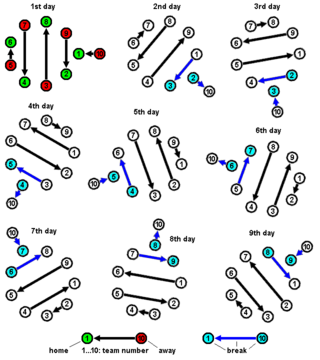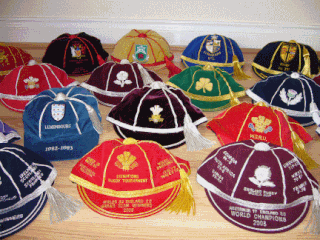
In sports analytics, sabermetrics is the empirical analysis of baseball, especially baseball statistics that measure in-game activity. Sabermetricians collect and summarize the relevant data from this in-game activity to answer specific questions. The term is derived from the acronym SABR, which stands for the Society for American Baseball Research, founded in 1971. The term "sabermetrics" was coined by Bill James, who is one of its pioneers and is often considered its most prominent advocate and public face.
Message Passing Interface (MPI) is a standardized and portable message-passing standard designed to function on parallel computing architectures. The MPI standard defines the syntax and semantics of library routines that are useful to a wide range of users writing portable message-passing programs in C, C++, and Fortran. There are several open-source MPI implementations, which fostered the development of a parallel software industry, and encouraged development of portable and scalable large-scale parallel applications.

A child prodigy is a person under the age of ten who produces meaningful work in some domain at the level of an adult expert. The term is also applied more broadly to describe young people who are extraordinarily talented in some field.

A round-robin tournament or all-play-all tournament is a competition format in which each contestant meets every other participant, usually in turn. A round-robin contrasts with an elimination tournament, wherein participants are eliminated after a certain number of wins or losses.

A performance indicator or key performance indicator (KPI) is a type of performance measurement. KPIs evaluate the success of an organization or of a particular activity in which it engages. KPIs provide a focus for strategic and operational improvement, create an analytical basis for decision making and help focus attention on what matters most.
A ranking is a relationship between a set of items such that, for any two items, the first is either "ranked higher than", "ranked lower than", or "ranked equal to" the second. In mathematics, this is known as a weak order or total preorder of objects. It is not necessarily a total order of objects because two different objects can have the same ranking. The rankings themselves are totally ordered. For example, materials are totally preordered by hardness, while degrees of hardness are totally ordered. If two items are the same in rank it is considered a tie.
Alpha is a measure of the active return on an investment, the performance of that investment compared with a suitable market index. An alpha of 1% means the investment's return on investment over a selected period of time was 1% better than the market during that same period; a negative alpha means the investment underperformed the market. Alpha, along with beta, is one of two key coefficients in the capital asset pricing model used in modern portfolio theory and is closely related to other important quantities such as standard deviation, R-squared and the Sharpe ratio.
A record chart, in the music industry, also called a music chart, is a ranking of recorded music according to certain criteria during a given period. Many different criteria are used in worldwide charts, often in combination. These include record sales, the amount of radio airplay, the number of downloads, and the amount of streaming activity.
Magnetic particle imaging (MPI) is an emerging non-invasive tomographic technique that directly detects superparamagnetic nanoparticle tracers. The technology has potential applications in diagnostic imaging and material science. Currently, it is used in medical research to measure the 3-D location and concentration of nanoparticles. Imaging does not use ionizing radiation and can produce a signal at any depth within the body. MPI was first conceived in 2001 by scientists working at the Royal Philips Research lab in Hamburg. The first system was established and reported in 2005. Since then, the technology has been advanced by academic researchers at several universities around the world. The first commercial MPI scanners have recently become available from Magnetic Insight and Bruker Biospin.
In professional sports, notational analysis is the study of movement patterns, strategy and tactics in team sports. Successful patterns of play can be identified and used in subsequent matches. Notational analysis has a history in dance and music notation. Notational analysis is a way that critical events in a performance can be quantified in a consistent and reliable manner.

In sport, a cap is a player's appearance in a game at international level. The term dates from the practice in the United Kingdom of awarding a cap to every player in an international match of rugby football and association football. In the early days of football, the concept of each team wearing a set of matching shirts had not been universally adopted, so each side would distinguish itself from the other by wearing a specific sort of cap.
The following is a glossary of traditional English-language terms used in the three overarching cue sports disciplines: carom billiards referring to the various carom games played on a billiard table without pockets; pool, which denotes a host of games played on a table with six pockets; and snooker, played on a large pocket table, and which has a sport culture unto itself distinct from pool. There are also games such as English billiards that include aspects of multiple disciplines.

The Human Development Report (HDR) is an annual Human Development Index report published by the Human Development Report Office of the United Nations Development Programme (UNDP).
Dartitis is a condition which can affect darts players, and severely damage their performance. It can be compared to 'the yips', an expression used to describe apparent loss of fine motor skills without any explanation. The term is used in reference to players who struggle with some kind of psychological problem with their technique and/or release of their darts.

Poverty is measured in different ways by different bodies, both governmental and nongovernmental. Measurements can be absolute, which references a single standard, or relative, which is dependent on context. Poverty is widely understood to be multidimensional, comprising social, natural and economic factors situated within wider socio-political processes. The capabilities approach argues that capturing the perceptions of poor people is fundamental to understanding poverty.

A computer cluster is a set of computers that work together so that they can be viewed as a single system. Unlike grid computers, computer clusters have each node set to perform the same task, controlled and scheduled by software. The newest manifestation of cluster computing is cloud computing.
Return on investment (ROI) or return on costs (ROC) is a ratio between net income and investment. A high ROI means the investment's gains compare favourably to its cost. As a performance measure, ROI is used to evaluate the efficiency of an investment or to compare the efficiencies of several different investments. In economic terms, it is one way of relating profits to capital invested.
A chess rating system is a system used in chess to estimate the strength of a player, based on their performance versus other players. They are used by organizations such as FIDE, the US Chess Federation, International Correspondence Chess Federation, and the English Chess Federation. Most of the systems are used to recalculate ratings after a tournament or match but some are used to recalculate ratings after individual games. Popular online chess sites such as chess.com, Lichess, and Internet Chess Club also implement rating systems. In almost all systems, a higher number indicates a stronger player. In general, players' ratings go up if they perform better than expected and down if they perform worse than expected. The magnitude of the change depends on the rating of their opponents. The Elo rating system is currently the most widely used.

Multidimensional Poverty Indices use a range of indicators to calculate a summary poverty figure for a given population, in which a larger figure indicates a higher level of poverty. This figure considers both the proportion of the population that is deemed poor, and the 'breadth' of poverty experienced by these 'poor' households, following the Alkire & Foster 'counting method'. The method was developed following increased criticism of monetary and consumption based poverty measures, seeking to capture the deprivations in non-monetary factors that contribute towards well-being. While there is a standard set of indicators, dimensions, cutoffs and thresholds used for a 'Global MPI', the method is flexible and there are many examples of poverty studies that modify it to best suit their environment. The methodology has been mainly, but not exclusively, applied to developing countries.
The Mazziotta–Pareto index (MPI) is a composite index for summarizing a set of individual indicators that are assumed to be not fully substitutable. It is based on a non-linear function which, starting from the arithmetic mean of the normalized indicators, introduces a penalty for the units with unbalanced values of the indicators . Two version of the index have been proposed: (a) MPI, and (b) adjusted MPI (AMPI). The first version is the best solution for a 'static' analysis, whereas the second one is the best solution for a 'dynamic' analysis. For a comparison between the two versions, see Mazziotta and Pareto (2015).








